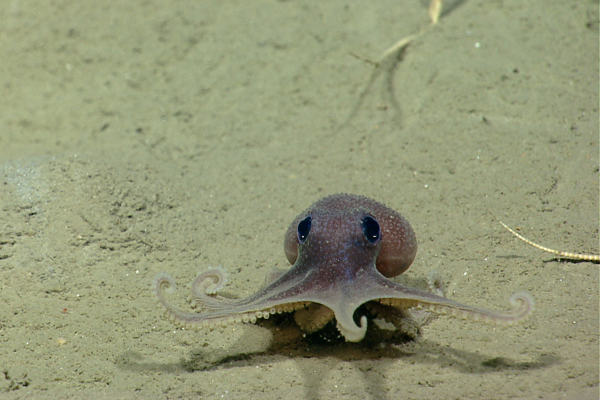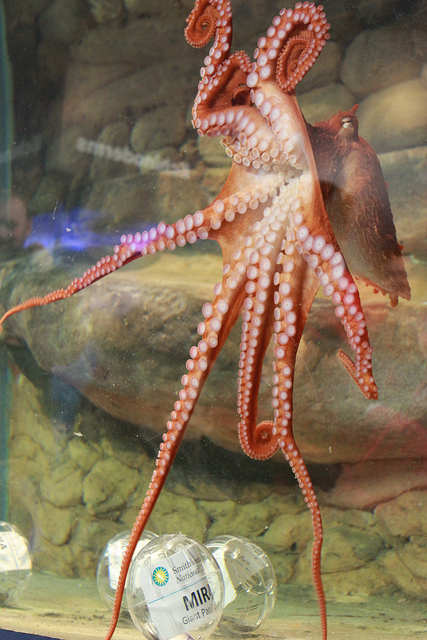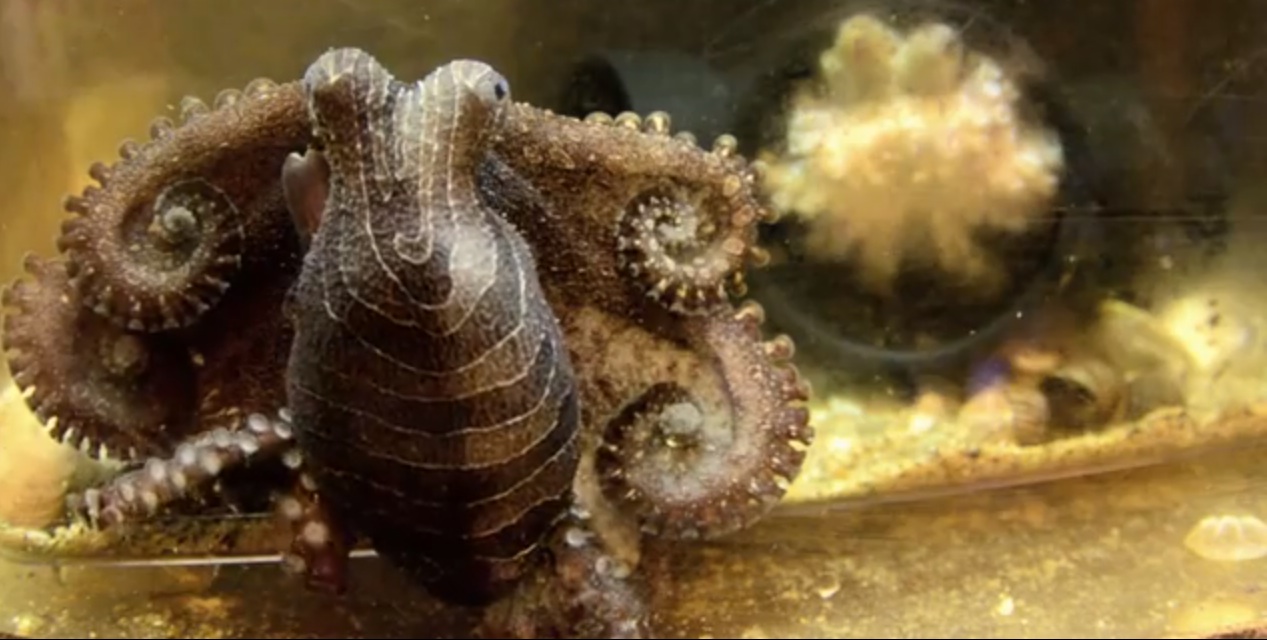Odd Octopus: What It's Like to Be a Clever 8-Armed Creature

Imagine for a moment what it might be like to be an octopus.
You're smart. You might even be able to use tools. But most of your brain cells are packed into your limbs — eight infinitely flexible arms that seem to think for themselves. You're a loner. You seek contact only to mate. You also see only in shades of green (though to you, it probably all looks gray). And despite your own colorblindness, you can imitate an amazing breadth of colors, changing the hue of your body in a fraction of a second. Perhaps it's that you can see with your skin. Your ability to vanish from predators is sometimes enhanced by a well-timed deployment of a cloud of dark ink. And you do all this without a spine.
Though humans have been pondering (and eating) these cephalopods for centuries, it's still difficult for people to wrap their minds around octopuses, the most intelligent invertebrates on Earth.
To learn more about these marvels, LiveScience caught up with Katherine Harmon Courage, a freelance journalist and contributing editor for Scientific American, to talk about her new book "Octopus! The Most Mysterious Creature In the Sea" (Current Hardcover, October 2013). [8 Amazing Octopus Abilities]
The following Q&A has been edited lightly for clarity and brevity.
LiveScience: How'd you get started writing about octopuses?
Katherine Harmon Courage: I was working as a reporter at Scientific American and a study crossed my desk one day saying that octopuses had been observed using tools, and I kind of did a double take and thought, "What? Octopuses are invertebrates. What are they doing exactly? Are they using hammers? Or building bicycles down there?"
Sign up for the Live Science daily newsletter now
Get the world’s most fascinating discoveries delivered straight to your inbox.
So I read the study and these researchers had observed these octopuses that were collecting coconut shell halves. When they were feeling threatened or a little scared it seemed they would use these shells as shelter — they would take two of them and kind of snap them closed and hide inside and hold them shut with their suckers. The researchers suggested that this was an example of foresight, planning and of these octopuses thinking about materials in ways that we really wouldn't expect an invertebrate to do.
The real clincher was that it came with this amazing video showing these pretty small octopuses awkwardly carrying these unwieldy coconut shell halves and then hiding inside when they were startled by the researchers who were filming them. I just realized that these animals had so much more to offer — I had no idea how cool they were.
LS: What makes octopuses so good at camouflaging themselves?
K.H.C.: We still don't know exactly how they perceive their environment. Studies have shown that their eyes seem to be colorblind, and so we're not sure exactly how they can pick up on these really subtle colors in their environment to so successfully camouflage against them. Current research suggests they might actually be able to see with their skin. They have these light-sensing cells in their skin [called opsins], and so perhaps they're picking up color that way and just doing it super locally. And then their skin is filled with these little pigment-filled sacs called chromatophores, and these can expand and contract and change the overall color and pattern on the octopus skin. [Cuttlefish Cuties: Photos of Color-Changing Cephalopods]
LS: I was really fascinated to learn that when octopuses use camouflage, they don't exactly mimic the objects they're trying to blend in with. Why is that?
K.H.C.: A study came out recently showing that instead of taking an overall environmental snapshot and averaging it to disappear with a general leaf pattern, as we might think of camouflage on land, they're in fact camouflaging themselves to look like a specific object in the environment, which actually solves a lot of problems of camouflage. If something is generally camouflaged, it might disappear from 100 meters away, but [from] much closer or at a different angle, it could be immediately obvious. That's why octopuses can camouflage looking like a plant or a rock or a shell or something else on a coral reef rather than the entire coral reef itself.
LS: Personally, probably the creepiest thing about octopuses is their eyes, which look somewhat similar to ours, even though, as you write, the last common ancestor of octopuses and humans was likely a sightless worm that dates back to 500 million years ago.
K.H.C.: It's just incredible that somehow given our really different evolutionary paths we've ended up with such similar lens-based eyes that can focus and really are extremely attuned to motion. I think it speaks to some of these really basic genetic underpinnings that we, whether we would like to admit it or not, share with octopuses.
Another interesting commonality is that a study a few years ago showed that octopuses, if they're trying to perform really exact movements, they'll turn their arms almost into a jointed arm. They will pretend like they have these solid joints and make their arms into more stiff segments, kind of like our own. They called it an octopus making an elbow.
LS: Speaking of their arms, you wrote about how they can act independently of the octopuses' central brain. How does that work?
K.H.C.: That's another thing we're still figuring out. About two-thirds of all their neurons are distributed in their arms whereas we have most of our neurons in our brain, which is definitely the executive controller for our bodies — the CPU, if you will.

The octopus, as one researcher put it to me, has something more like the Internet — more like a cloud-based intelligence system. We're still figuring out how some of the decision-making in terms of movement and problem solving might actually be made in their arms without their central brain being aware of it. Research right now is clinging to the fact that they probably just send their arms a general directive, say, "Arm! Go catch this crab!" and then the arms will work [both] together and independently to make sure that happens. This allows the octopus not to be bogged down, or at least not have its central brain bogged down, with trying to control eight incredibly flexible sensitive arms.
LS: Octopuses are quite antisocial, but they do come together briefly to mate — how exactly do they mate?
K.H.C.: They have a couple of different strategies and it seems to depend on the species. In one — it's hard to call it traditional, I guess — males have a specialized arm they use for mating. They can send spermatophores, the little packets of sperm and genetic material, down the specialized arm and they can insert it into the female's mantle through her funnel.
Some species, they don't seem to like this closeness possibly because a lot of octopuses are actually cannibalistic. Perhaps the safer sex strategy for the octopus is … the males will actually detach that arm and give it all over to the female and then she can take it and use it pretty much whenever she's ready to lay her eggs. That's used in a lot of species where there's a big size difference between the male and the female. There are some octopuses where the female can be close to 6 feet long, and the male is the size of a walnut so this poor little guy isn't gonna risk getting too close for too long. [Wild Sex: Find Out How Other Animals Do It]
LS: Besides other octopuses, what do they eat?
K.H.C.: They seem to eat just about anything, and some individual octopuses do seem to have a taste preference for different foods, but in general their primary favorite foods seem to be crabs and other shelled mollusks like clams and mussels, which is pretty impressive because those aren't even easy for us to open with all of our myriad tools. But the octopuses are so strong; they can usually tear the shells open or break into them with their beak, which is really sharp, and then suck out their dinner.
LS: You talked to several researchers who are building robots or materials inspired by octopuses. What makes these animals such good models?
K.H.C.: There's this huge challenge of trying to build a soft-bodied robot, which might not sound like a big challenge until you consider how locked-down we've been in this really rigid robotic world with joints and hard components. There's this huge undertaking of trying to make absolutely everything in that robot soft so like an octopus it could squeeze into small places which would be really useful for search and rescue or just exploration.
From the materials standpoint, a lot of researchers are trying to mimic their camouflage ability, applying a lot of nanotechnology and trying to develop material that, like an octopus, can both sense the color and the light conditions around it and then instantaneously mimic that or send that signal back out. That could obviously be used in the military for light and color, but also for things like radar and sonar, so instead of just disappearing under the sonar signal, [the material] could actually become invisible by reemitting the sonar. [Biomimicry: 7 Clever Technologies Inspired by Nature]
LS: Besides the fact that octopuses are not called octopi, what do you think is the biggest misconception about the animals?
K.H.C.: I think a lot of people still have this image in their minds of the "kraken," this huge mysterious, monstrous sea beast. There are definitely some huge squid that live out in the ocean that conceivably, if they wanted to, could probably take out a small boat. But octopuses don't really get that big to be a threat to any kind of seacraft. And also they're not generally malicious. There are a lot of stories of divers [who] have an octopus take off their mask or their respirator, which is obviously dangerous, but usually the octopus is just curious; it's just checking out this other animal that's entered its area. [Release the Kraken! Photos of Giant Squid]
LS: Do scientists know how many octopuses there are, or if they face any threats in their environment like global warming?
K.H.C.: One of the really cool adaptations is their blood. Instead of being iron-based like our blood, it's copper-based, which makes them have blue blood, which is really awesome. But the downside to that is that they become really sensitive to pH changes. So with climate change and ocean acidification, they could be in some serious danger.

But the big challenge to octopus study in the wild is that we have no idea how many octopuses are out there. They're just almost impossible to count and to track. For schools of fish like cod or tuna, you can cast a wide net; you can even tag some of them. But octopuses will not be tagged. They'll take out just about any radio transmitter you try to put in or on them. And they're so solitary, as you mentioned. They just kind of hide in these little dens and crevices on the bottom of the ocean by themselves, so you can't really catch a school of octopus and figure out how old they are and what the population dynamics are. We've really had to guess to estimate what populations might be, mostly based on fishery catches to see if people in [certain] areas are bringing in as many octopuses as they have in the past.
LS: How do we know what octopuses were like in the past?
K.H.C.: The oldest octopus fossil we have is almost 300 million years old, so these guys are older than T. rex, older than the dinosaurs. But we have a really poor fossil record of them, because, obviously having no bones, they don't fossilize very well. One of the researchers I spoke to studied these fossils, and she just said it's a matter of finding really subtle octopus-shaped stains on a rock, which can be super challenging. You just have to know good places to look. [Known octopus fossils] don't show a lot of evolutionary change, so we're just trying to figure out exactly, for example, when the ink sac developed and basic developments of anatomy like that.
LS: I love how your book mentions the octopuses that show up again and again in sci-fi. Do you have a favorite fictional octopus or octopus-like character?
K.H.C.: I was so amazed by Doctor Octopus [one of Spider-Man's foes in the Marvel universe] when I was researching the book. I haven't been a huge comic book follower, but it was just incredible how many details the creators of this character got right. I don't know if they put in the research or if it was just a lot of lucky guesses, but he was super smart, he had independent control of these arms, and just the small detail that he was just a little bit myopic. We've only recently learned that octopuses don't see very well into the distance.
Follow Megan Gannon on Twitter and Google+. Follow us @livescience, Facebook & Google+. Original article on LiveScience.










